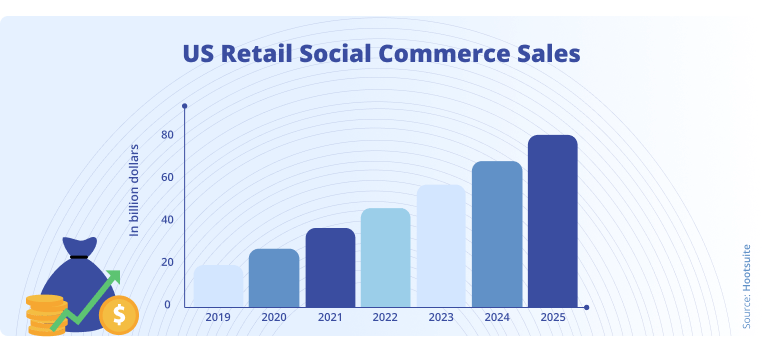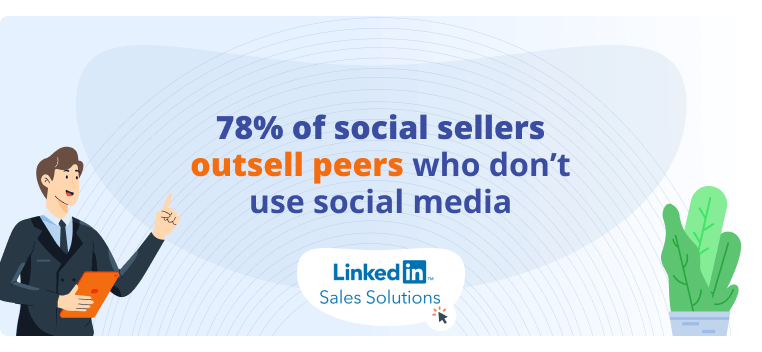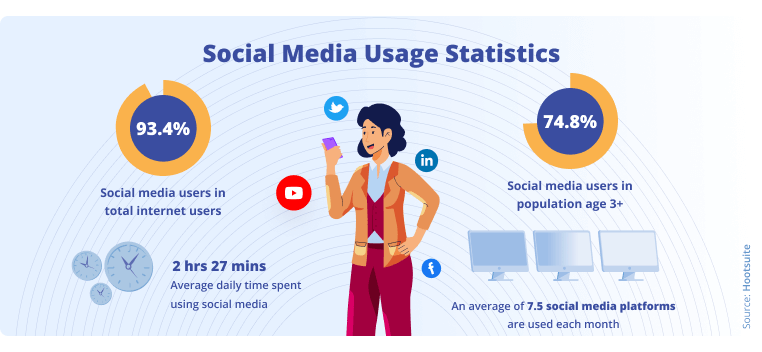Traditional selling techniques like outdoor advertising and cold calling have existed for a long time and still hold a place in sales. However, new-age techniques like social selling are quickly becoming the go-to strategies for salespeople and their marketing counterparts.
Social selling means leveraging your social media connections to build trusted relationships and attract the right sales prospects. It is a tool that turns brand awareness into sales. As a sales strategy, social selling allows brands to reach prospective customers by connecting on a personal level.
Over the years, social selling has gained significant popularity because of its multiple advantages. The primary benefits of social selling include:
-
Increased pipeline
-
Better, warmer leads
-
Boosted win rates
-
Enhanced deal sizes
Social selling is not only about connecting with new people and adding new contacts to your list. It is about connecting with prospects and presenting your brand as a solution to existing problems. This helps you build trust and create a rapport with your prospective customers.
This article gives you some specific social selling statistics to help you put these benefits into perspective.
Role of Social Media in the Sales Industry
Brands are using social media to generate leads and create brand awareness. A large number of active users on social media platforms allows you to gather data about sales prospects and reach them effectively. All social media networks provide discussion or conversation tools that you can leverage to reach prospective customers.
Some of the most popular social media platforms that you can use to generate sales prospects and create brand awareness are:

1. Facebook (Meta)
Facebook is the largest social media platform based on monthly active users: it has 1.96 billion daily active users and 2.94 billion monthly active users. A Facebook user spends approximately 33 minutes on the platform daily.
Facebook is also the most popular platform among businesses. As of the fourth quarter of 2020, over 200 million businesses were using Facebook for brand awareness, driving traffic, connecting with customers, and boosting overall sales.
2. Instagram
Instagram, a Meta subsidiary, is one of the fastest growing social media platforms with over two billion monthly active users. Over 60% of Instagram users are between 18 and 34, making it a great platform if you’re targeting Gen Z.
Instagram is also an incredible tool for brand visibility: 58% of users have gained interest in a brand or product after seeing it on Instagram Stories.
3. X/Twitter
X/Twitter is the fourth most-visited website in the world, and the average visit duration is over ten minutes. It is also deemed the best platform for discovering new brands and services.
Twitter has also launched Twitter Spaces, where conversations happen through live audio. According to Twitter, a 10% increase in Twitter Spaces’ conversations has resulted in a rise of 3% in total sales volume. Using Twitter Spaces, you can engage authentically with your followers by connecting on a personal level. You can also expand your reach and make your brand’s voice heard.
4. LinkedIn
LinkedIn is a popular platform for creating brand awareness and increasing sales volume. It has over 830 million members across 200 countries globally, and more than 58 million companies have a social media presence on LinkedIn. As of their Q3 of 2022, LinkedIn has recorded a 22% year-on-year increase in platform engagement.
The LinkedIn platform has a Sales Navigator tool to reach the right prospects, understand key insights, and engage buyers. Brands advertising on LinkedIn have seen a 33% increase in purchase intent from ad exposure.
5. TikTok
TikTok, the popular short-form video app, allows users to create and share short videos on any topic. Rising in popularity after exiting the Chinese market in 2017, TikTok is now prevalent in 154 countries with over 3 billion downloads to date. TikTok has amassed over 1 billion monthly active users who, on average, spend a whopping 95 minutes per day binging content on the app. And while TikTok is clearly a powerful B2C platform, B2B’s are starting to crack the code too. By participating in trending hashtags and curating content on the same hashtags as their SEO strategy, B2B organizations are closing in on the captivated audiences to inform, educate, hire, and elevate their business.
Traditional Selling Statistics vs. Social Selling Statistics
Companies globally prioritize social selling as their preferred sales technique and for good reason: 78% of social sellers outsell peers who don’t use social media.

Using social media as a platform for social selling, you can connect with prospective customers by sharing relevant articles about your brand, products, and services instead of sending a traditional follow-up mail.
Over 40% of salespeople believe that sales prospecting is the most challenging part of the sales process. To connect with a buyer, a salesperson must make an average of 18 calls. Prospective buyers open only 24% of the emails shared by the sales team.
Social selling lets you engage in meaningful and mutually beneficial conversations with prospects. Following are some of the statistical facts that provide clarity on why social selling is gaining popularity:
-
Social selling provides 45% more sales opportunities than traditional sales.
-
The social selling representatives are 51% more likely to achieve their sales quota.
-
62% of B2B customers respond to salespeople who share insights that are relevant to the buyer.
-
Over 76% of the buyers are ready to connect for sales over social media.
-
More than 50% of the revenue for 14 major industries was generated through social selling in 2021. These industries include finance, computer and network security, and health care.
-
31% of the B2B professionals believe they have built stronger relationships with clients through social selling.
Why Is Social Selling the Future of Sales?
There are four key reasons why social selling is the preferred method to generate sales. Social selling helps in:

Forming Trustworthy Relationships
Social selling offers tremendous opportunities for brands to showcase the value they can uniquely provide. Through existing social media connections, your employees can leverage trust from prospects through regular engagement with each other. Use the combination of value offered and familiarity (through social networks) as a powerful tool to build trusting relationships with prospects.
Capturing the Market
40% of B2B buyers use social media for research before making purchasing decisions. Moreover, as more millennials become decision-makers in organizations by taking up senior-level positions, the scope of social selling through digital platforms increases.
Staying Ahead of the Curve
Digital marketing plays a significant role in influencing the buyer’s purchase decision. Companies can track the buyer’s social media activity through social selling and start a conversation when the buyer is ready. This will help you generate valuable sales leads and build meaningful relationships with clients.
Winning Through Connections
You can create relevant content to reach organic audiences, thus increasing traffic to your website while building authentic relationships through the entire social selling process. In this scenario, even if your sales leads do not turn into customers, they will recommend you to their connections, which would also increase your reach.
Top Challenges Faced by Social Media Marketers

With almost 3.6 billion people using social media platforms globally, reaching sales prospects through social media is advantageous. However, social selling comes with various challenges, which include:
Getting the Right Engagement or Reach
Considering the competitive business environment, 32.2% of social media professionals face challenges in reaching or engaging the target audience with their brand. They struggle with getting social media users to notice their content, understand the users’ perspectives, and stand out against the competition.
Brands can mitigate this problem by:
-
Introducing employee advocacy to their organization and allowing their employees to help in their efforts
-
Partnering with a micro-influencer
-
Making data-driven decisions like posting more content related to the more engaging posts
-
Making it easy for users to interact with you through polls or question boxes
-
Increasing your posting frequency. However, you must do this after researching and developing the kind of content that users want to see
-
Investing in paid ads to get your content to reach more people
Executing a Consistent Strategy
Creating a social media strategy and successfully executing it is the largest obstacle for 9.2% of social media professionals. Here, the professionals struggle with managing too many platforms simultaneously, monitoring performance, or tracking outcomes.
If you’re having trouble with your social media strategy, you should:
-
Set clear business goals. These goals may include increased brand awareness, increased web traffic, generated leads, or enhanced community engagement.
-
Create separate landing pages to track which campaigns are doing well and which aren’t.
-
Determine the social media platform that is best suited for your business and make that platform a priority.
-
Segment your mediums. Review your marketing mix and determine where the results are coming from. Your social media strategy may include organic, brand, paid, and employee advocacy, all of which are positioned slightly differently.
Balancing and Measuring a Strong ROI
Measuring ROI is another big challenge that 5.7% of social media professionals struggle with. This challenge covers measuring the impact created by every post and the overall marketing initiatives.
To get a better understanding of your ROI, you should:
-
Establish SMART goals for each campaign, i.e., specific, measurable, achievable, realistic, and time-bound goals.
-
Set measurable objectives and compare the actual results to see where the problem lies.
-
Maintain performance reports as they will eventually help you define your strategies in a better manner.
Steps To Implement a Successful Social Selling Strategy

Social selling is not just about selling products and services but building relationships and spreading brand awareness. This helps you engage with potential buyers, understand their requirements, and connect with them when they are ready to purchase.
The following steps can help you implement a successful social selling strategy:
Align Marketing and Sales Leadership
The sales and marketing executives within your organization can contribute to a successful social selling strategy. The marketing team can provide relevant content when you connect with the customer. This will directly help in targeting suitable prospects.
Identify the Best Social Platforms for Your Needs
Many social media platforms are available, each with pros and cons. You must choose the right platform considering your target audience and the total number of active users.
Set LinkedIn Profiles for the Entire Team
On social media platforms, a brand is represented by its employees. Companies must encourage a professional LinkedIn profile for all team members. To reach prospective customers, they must use an appropriate profile photo and keywords in their LinkedIn summary, headline, and job description. While your sales team may already be leveraging LinkedIn as another form of outreach, other members of your team can also contribute to your efforts. Their presence matters, too.
Provide Training to the Sales Team
The sales team must clearly understand the tools and features of social media. This will help them connect with and research potential buyers.
LinkedIn Sales Navigator is one of the most powerful social media tools that help you connect with potential customers. This tool has helped Genesys, a software company, generate leads 2.2 times faster and achieve a higher win rate of 16% compared to those who didn’t use the tool.
Connect With Potential Customers
The primary goal of social selling is to connect and build healthy relationships with potential buyers. Think of social media as one giant offsite conference. You wouldn’t start a conversation at a conference going in for the demo, would you? Likely not. Rather use these social selling opportunities to engage, inform, and grow your relationship with others. What you’ll often find is when they are in the market for what you are selling, you’ll be top of mind with a foundation of trust and value.
Evaluate Your Social Selling Strategies
You must regularly track, check, and evaluate your social selling strategies. This will help you determine the success achieved through social media platforms. You’ll want to look at both your successful engagements on social as well as In Mail or DM responses to cold outreach. Those can be very telling if you’re hitting the right tone or missing it completely.
Stay Updated With Your Competitors’ Strategies
Keeping an eye on your competitors' social selling strategy is essential as it can help you stay updated with relevant trends and improve your social selling strategy.
Scale Your Social Selling Efforts with an Employee Advocacy Program
As you saw from the social selling statistics above, social selling is a powerful tool to create deeper relationships with prospects and increase brand loyalty and trust. Moreover, it also results in increased sales and larger profits. When combined with an employee advocacy program, a good social selling strategy can set you up for success.
Employee advocacy platforms make sharing on social media easy for sales reps. They also incentivize them to post on their social media, helping your business reach more potential customers.
Sign up for a Free GaggleAMP Trial to see it in action yourself.











